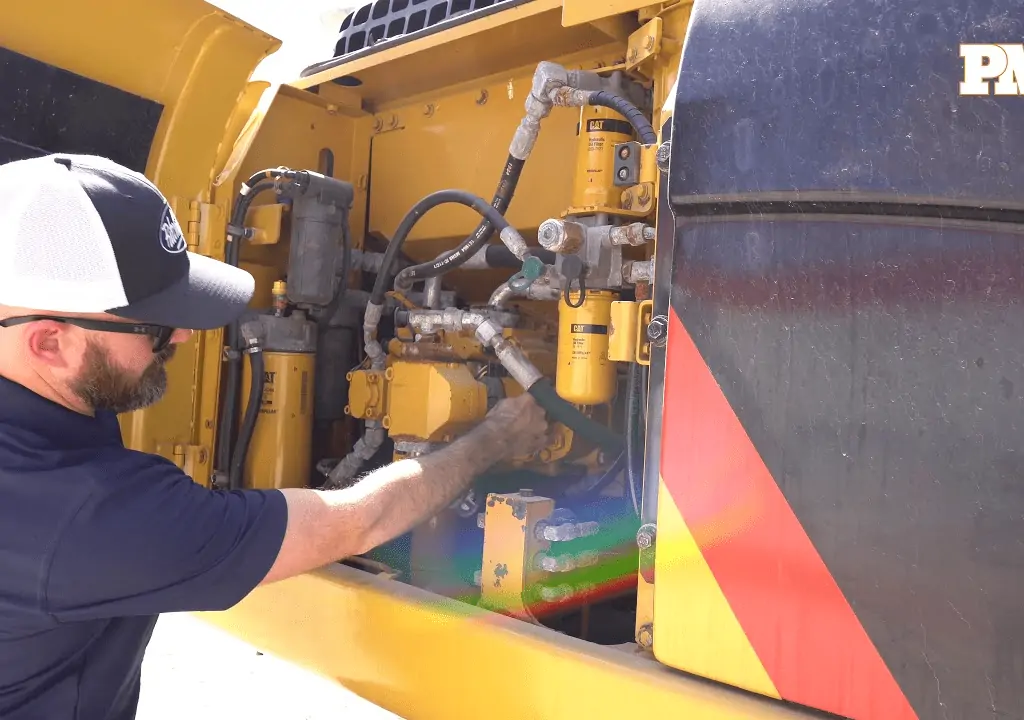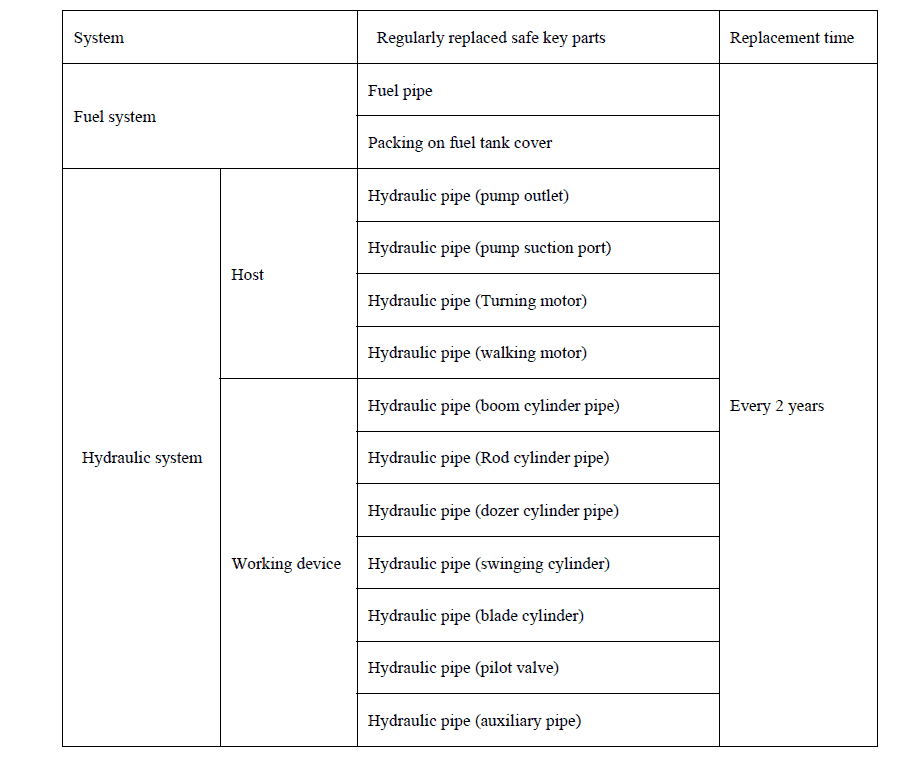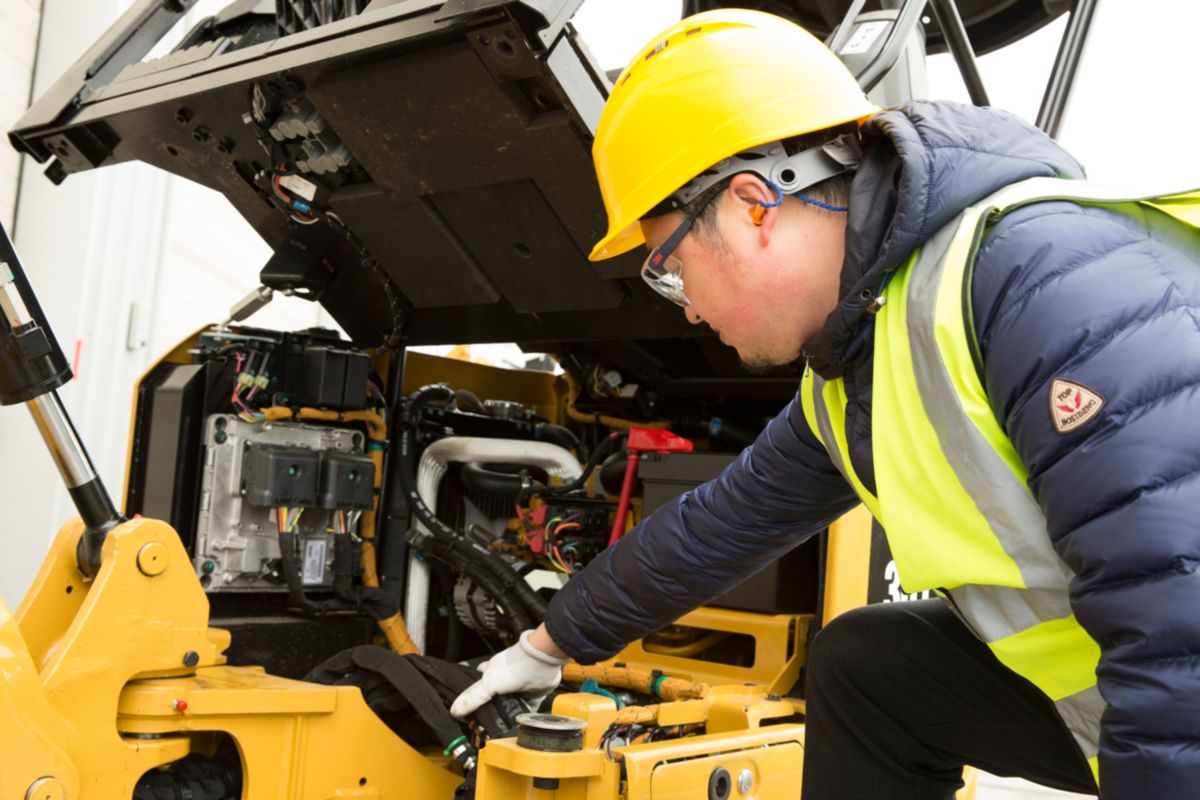جدول المحتويات
تبديلمقدمة
هل أنت من يبحث عن الأفضل؟ حفارة صغيرة والتي يمكن أن تلبي جميع احتياجاتك؟ لا داعي للقلق أكثر. يعد التشغيل والصيانة نشاطًا مهمًا سواء كنت تقوم بتشغيل الحفارات أو الشاحنات المهنية.
تعد الحفارة الصغيرة واحدة من أهم قطع المعدات لموقع العمل. يُطلق على الحفارة التي يتراوح وزنها بين 3000 و3999 رطلاً ويمكنها حفر حفرة بعمق 7.8 قدم اسم "الحفارة" حفارة صغيرة. تُعرف الحفارات الصغيرة أيضًا بالحفارات المدمجة. الحفارة عبارة عن مركبة متحركة متميزة بأذرعها وكبائنها الدوارة ودلاءها ومساراتها المتحركة. تأتي هذه الآلة الرائعة مع مجموعة متنوعة من الملحقات مما يجعلها أكثر فائدة. تلعب الحفارات المدمجة دورًا حيويًا في موقع البناء.
هنا سوف تتعرف على عمليات وصيانة الحفارات الصغيرة. كل ما عليك هو مواصلة قراءة المقال حتى النهاية. لذلك دعونا نحفر!
أي مشروع يتطلب الحفر أصبح أسهل 100 مرة باستخدام الحفار. ومع ذلك، يجب أن يقوم بتشغيل الحفار شخص يفهم الاستخدام الصحيح له. لكن تشغيل الحفارة ليس بالأمر الصعب.
توفر الكابينة الدوارة للحفارة الصغيرة رؤية كاملة، مما يجعل العمل أسهل. لقد قمنا هنا بإدراج أفضل 21 خطوة لتشغيل الحفار الصغير الخاص بك. دون مزيد من المستحقات دعونا نبدأ.

21 خطوة لتشغيل الحفارة الصغيرة الخاصة بك
- اختيار الحفار الصغير المناسب
عندما يتعلق الأمر حفارات التشغيل، يعد اختيار الجهاز المناسب هو الخطوة الأكثر أهمية. سيعمل الحفار الصغير المناسب على تقليل عبء العمل لديك والعكس صحيح. تأتي الحفارات الصغيرة بأحجام متنوعة بدءًا من الحفارات الصغيرة جدًا (أقل من 4000 رطل) وحتى الحفارات الثقيلة. إذا كنت تريد ببساطة القيام بعملية الحفر، فلن تحتاج إلى شراء حفار صغير فائق الكفاءة.
بالنسبة لمشروع ري DIY، أو مشروع محدود المساحة، أو مشروع بسيط لحفر الخنادق/الردم، اختر أصغر الحفارات الصغيرة التي يمكنك العثور عليها. ولكن بالنسبة لعملية تنسيق حدائق كبيرة، فأنت بحاجة إلى آلة بسعة 3-3.5 طن مثل Bobcat 336 وربما تكون أكثر ملاءمة لهذه المهمة.
- مقارنة الإيجار مقابل تكاليف العمالة
إذا لم يكن لديك مشروع طويل الأمد، فلن تحتاج إلى شراء حفارة صغيرة. بدلاً من ذلك، يمكن أن يكون استئجار حفار صغير هو الخيار الأفضل. قارن تكلفة الإيجار والعمالة للحفارات الصغيرة قبل الاستثمار في استئجار عطلة نهاية الأسبوع. عادةً، يمكن أن يكلفك استئجار حفار مدمج فعال حوالي 150 دولارًا أمريكيًا في اليوم.
يمكن أن يكون استئجار حفار صغير لمشروع قصير المدى قرارًا رائعًا. ومع ذلك، فإن تكلفة الإيجار ترتفع دائمًا مع زيادة الطلب المرفقات. حتى الآن، يمكن أن يكلفك المشروع الأسبوعي باستخدام الحفار حوالي 250-300 دولار (الولايات المتحدة). لكن التأمين البنكي يمكن أن يساعدك بالتأكيد في هذا الصدد.

- مظاهرات الآلة
تذكر دائمًا أنه قبل تشغيل الحفارة الصغيرة، عليك أن تتعرف على الآلة. اسأل الشركة المصنعة عما إذا كانت تسمح بعرض الجهاز. كثيرة كبيرة الشركات المصنعة للحفارات سوف توفر لك هذه التسهيلات. لديهم منطقة صيانة كبيرة حيث تسمح لك بالتعرف على جهازك
ومع ذلك، فإن أفضل الشركات المصنعة ستسمح لك أيضًا بالشعور بالجهاز مع بعض الإشراف من ذوي الخبرة. كثير من الناس يهملون هذا الجزء لأنهم لا يعتبرونه مهما. لا تشتري آلة أبدًا دون فحصها بشكل صحيح.
- تحقق من دليل المستخدم
قبل الصعود إلى الحفارة، يجب عليك مراجعة دليل المستخدم. وسوف يطلعك على جهازك. تذكر أنه من المهم أن تشعر بالحفار أولاً قبل تشغيله فعليًا. لا تتردد في لمس كل شيء بلطف على حفاراتك الصغيرة. في حال كنت لا ترغب في قراءة الكتاب اليدوي بأكمله.
تسهل عليك العديد من العلامات التجارية المصنعة للحفارات الصغيرة خريطة الموقع. إن فهم الخريطة بشكل صحيح سيساعدك على التعرف على الأزرار.
تذكر، ليست كل الحفارات الصغيرة متشابهة! سوف تجد الاختلافات في مختلفة
العلامات التجارية ل حفارات صغيرة.
- تعرف على التحذيرات والملصقات الخاصة بالحفارات الصغيرة
أثناء تشغيل الحفارة الصغيرة، ستجد علامات وملصقات تحذيرية مختلفة. ومن الحكمة أن تتعرف عليهم. لا تحاول إهمالهم. تحقق من تلك الملصقات بشكل صحيح لأنها تحتوي على تحذيرات محددة. على جهازك الصغير، ستلاحظ أيضًا بعض معلومات الصيانة. تأكد من قراءتها.
ستساعدك مخططات المواصفات والمعلومات ذات الصلة بالإضافة إلى علامة الشركة المصنعة كثيرًا على فهم الجهاز. لا تحاول أن تكون أكثر من اللازم في الذكاء، حاول أن تفهم كل شيء قبل تشغيل الحفار.

- نقل الحفارات الصغيرة
إحدى ميزات الحفارة الصغيرة التي يحبها جميع المشترين هي حجمها. يمكن سحب الحفارة المدمجة على مقطورة للوصول إلى موقع العمل الخاص بك بكل سهولة. يعد نقل الحفارة الصغيرة أسهل من نقل أي جهاز بناء كبير آخر.
يمكنك سحب حفار صغير في أي مكان باستخدام شاحنة صغيرة عادية.
- اختبر الجهاز في مكان ما
يعد اختبار الجهاز خطوة مهمة أخرى تحتاج إلى معظم اهتمامك. ابحث عن منطقة مستوية وواضحة حيث يمكنك اختبار جهازك. الحفارات الصغيرة هي أكثر الآلات استقرارًا. يمكنهم الحفاظ على توازن جيد. تساعده المساحة الواسعة على الحفاظ على توازنه على الأرض غير المستوية.
ومع ذلك، يمكن أن تنقلب، لذا ابدأ تشغيلها على منطقة خالية أو أرض مستوية. إذا كنت غير محترف فلا تفكر في تجربة الرحلة بنفسك. تأكد من الاستعانة بمحترف لاختبار الجهاز في رحلته الأولى.
- ابحث عن الأجزاء التالفة
قبل أن تقوم بشراء أو تشغيل حفارة، قم بإلقاء نظرة حول الماكينة لرؤيتها بشكل صحيح. تحقق مما إذا كان هناك أي أجزاء مفككة أو تالفة أو مدمرة. هذه الأجزاء ستجعل الاستخدام خطيرًا. ابحث عن تسرب الزيت، أو تساقط الوقود الآخر، أو وصلات كابلات التحكم، أو المسارات التالفة، أو أي مشكلة محتملة أخرى.
تحقق من مستويات زيوت تشحيم المحرك وسائل التبريد في حفاراتك الصغيرة. هذه هي بعض إجراءات التشغيل القياسية لاستخدام الأجهزة وبنائها. اعتد على إعطاء كل آلة تقوم بتشغيلها مرة واحدة قبل تشغيلها.
- تركيب الحفارة الصغيرة
قم بتركيب جهازك. على يسار مقعد المشغل، ستجد مجموعة الذراع أو مجموعة التحكم. اقلبها للأعلى وبعيدًا عن الطريق للوصول إلى المقعد. اسحب الرافعة الموجودة على الطرف الأمامي (وليس عصا التحكم) في الاتجاه الصعودي. كل شيء سوف يتأرجح صعودا وعودة.
الآن أمسك بالجهاز المحمول المتصل بإطار المسدس، واخطو على المسار واسحب نفسك إلى سطح السفينة. تأرجح واجلس. اسحب الذراعين إلى الأسفل. ادفع ذراع التحرير لتثبيته في مكانه.

- تعرف على أدوات التحكم وأجهزة القياس الخاصة بالحفارات الصغيرة
أخيرًا عندما تكون في مقعد المشغل. انظر حولك وتعرّف على أدوات التحكم وأجهزة القياس. بالنسبة لنظام تشغيل المحرك الرقمي، يجب أن ترى لوحة المفاتيح وإلا ضع مفتاح الإشعال على وحدة التحكم. النفقات العامة على يمينك للسيطرة على الجهاز بسهولة أكبر.
اعتد على فحص درجة حرارة المحرك ومستوى الوقود وضغط الزيت أثناء تشغيل الحفار الصغير. قم بارتداء حزام الأمان للحفاظ على سلامتك داخل الآلة أثناء القيادة.
- اشعر بحركة عصي التحكم في الحفارات الصغيرة
كما ذكرنا أعلاه، لا تحتاج إلى تشغيل الحفار الصغير قبل الشعور به. أمسك عصا التحكم وحاول أن تشعر بحركتها. حركه بلطف قليلاً. تتحكم هذه العصا في حركة ذراع الرافعة/الدلو والتي تُعرف أيضًا باسم المعزقة. تتحكم عصا التحكم أيضًا في وظيفة التدوير التي تؤرجح الجزء العلوي من الجسم.
يوفر الجزء العلوي من الجسم أو الكابينة رؤية كاملة مما يجعل العمل أسهل. تصل عصا التحكم دائمًا إلى الوضع المحايد عندما يتم تحريرها أو تحريرها. هذا يوقف كل حركة تنتج عن استخدامه.
- تحقق من وجود ضوابط السائق/التوجيه
ستجد بين ساقيك قضيبين فولاذيين طويلين مع يد مثبتة في الأعلى. هذه هي ضوابط السائق. يتحكم كل واحد منهم في دوران المسار على الجانب الذي يقع فيه. سيؤدي دفعهم للأمام إلى تحرك الماكينة للأمام، والعكس صحيح.
ومع ذلك، فإن دفع أحدهما للأمام سيؤدي إلى دوران الآلة في الاتجاه المعاكس، وسحب العصا للخلف سيؤدي إلى دوران الآلة في اتجاه سحب العصا. حيث أن دفع إحدى العصا وسحب الأخرى سيؤدي إلى دوران الآلة في مكان واحد.
كلما دفعت هذه العصي أو سحبتها، زادت سرعة تحرك الحفار. لذا تأكد عندما يحين وقت التشغيل والانطلاق، قم بتشغيل عناصر التحكم هذه ببطء وسلاسة.
- تحقق من وجود عناصر تحكم عالية السرعة
على لوح الأرضية، سترى عنصري تحكم إضافيين. وهي الضوابط الأقل استخداما. على اليسار، يوجد إما دواسة صغيرة أو زر يمكن تشغيله بقدمك اليسرى. إنها وحدة تحكم عالية السرعة تستخدم لتعزيز مضخة القيادة وتسريع الماكينة.
ومع ذلك، يجب استخدام هذه الميزة على سطح مستو أو أملس. على الجانب الأيمن، ستكون هناك دواسة مغطاة بلوحة فولاذية مفصلية. تعمل هذه الدواسة على تدوير مجرفة الآلة إلى اليسار أو اليمين. لا يتعين على الجهاز التأرجح أو التدوير للوصول إلى موقعك.

- اختبر دواسة الوقود للحفارة الصغيرة
انظر إلى الجانب الأيمن وفي مقدمة لوحة العدادات، سترى رافعتين إضافيتين. الجزء الخلفي هو الخانق، الذي يزيد عدد دورات المحرك في الدقيقة، وعادةً كلما تم سحبه إلى الخلف، زادت سرعة المحرك. المقبض الأكبر هو التحكم في الشفرة الأمامية.
عندما تسحب هذه الرافعة فإنها سترفع الشفرة، والضغط على هذا المقبض سيخفضها. يمكن استخدام هذه الشفرة في البستنة أو دفع الحطام أو ملء الثقوب. كما أنها تستخدم أيضًا لتثبيت الماكينة أثناء الحفر باستخدام المعزقة.
- بدء تشغيل المحرك
الآن قم بتشغيل المحرك، مع المحرك الذي يعمل، يجب أن تكون حذرًا للغاية. تجنب الاصطدام العرضي بأي عصا تحكم مذكورة سابقًا. كل حركة من هذه العصا سوف تسبب استجابة فورية من الحفار الصغير.
- ابدأ بمناورة جهازك
مناورة جهازك. تأكد من رفع الشفرة الأمامية وذراع الرافعة. ادفع أذرع التحكم في التوجيه للأمام. إذا كنت لا تقوم بأي أعمال بستنة باستخدام الماكينة، فباستخدام شفرة الجرار، يمكنك التحكم في عصا واحدة بكل يد.
ومن المثير للاهتمام أن هذه العصي تقع بالقرب من بعضها البعض بحيث يمكنك بسهولة الإمساك بهما بيد واحدة. يمكنك الالتواء لدفع العصي أو سحبها أثناء الحركة. دع يدك اليمنى تكون حرة. سيساعدك ذلك على رفع أو خفض شفرة الجرار.
- التعود على التعامل مع الآلة بشكل صحيح
حرك الآلة قليلاً التعود على التعامل مع الآلة بشكل صحيح. إن تدويرها ودعمها سيجعلك تعتاد على التعامل معها وسرعتها. أثناء المضي قدمًا، انتبه للمخاطر. نظرًا لأن ذراع الرافعة أبعد من أفكارك، فقد يتسبب في أضرار جسيمة إذا اصطدم بشيء ما.

لذلك فمن الحكمة أن نفهم دليل التشغيل أو الدليل بشكل صحيح. لتجنب حدوث أي ضرر جسيم، تأكد من تحريك الحفار بسلاسة وبطء.
- جرّب وظيفة الحفر في حفاراتك الصغيرة
الميزة المدهشة للحفارة هي قدرتها على الحفر. يتعين عليك تجربة ذلك بمجرد حصولك على بعض المعلومات التشغيلية الأساسية حول عمق الحفر. ابحث عن مكان مناسب في منطقة التدريب الخاصة بك لاستخدام وظيفة الحفر وعمق الحفر.
تتحكم عصا التحكم الموجودة على الأذرع في حركة ذراع الرافعة والمحور والدلو. يمكن التحكم فيها جميعًا في أحد الوضعين اللذين يُطلق عليهما عادةً وضع الحفار الخلفي أو مجرفة الجنزير. عادةً ما يتم تصنيف هذه الإعدادات على أنها A أو F في نوع جهازك.
لاحظ أن الحفارات ذات الأوزان التشغيلية المختلفة سيكون لها أعماق حفر مختلفة.
- إدارة مقبض التحكم
إدارة مقبض التحكم. قم بخفض شفرة الجرار عن طريق دفع الكونسول الأمامي الموجود على يمينك للأمام. أمسك بعصا التحكم ولكن كن حذرًا، لا تحركهما حتى تصبح جاهزًا. ابدأ برفع وخفض قسم ذراع الرافعة الرئيسي. يمكن القيام بذلك عن طريق سحب عصا التحكم اليمنى بشكل مستقيم ودفعها للأمام لخفضها.
- تحريك عصا التحكم اليسرى
يمكنك تحريك عصا التحكم اليسرى للأمام وسوف يتأرجح قطاع ذراع الرافعة الثانوي لأعلى (بعيدًا عنك). سيؤدي سحب العصا إلى تأرجح ذراع الرافعة للخلف (نحوك). لإزالة الأوساخ أو جذوع الأشجار من الأرض أو الحفرة، يجب عليك إنزال الدلو في التربة.
الآن اسحب الذراع الأيسر للخلف لسحب الدلو لأعلى عبر التربة، أي تجاهك، أثناء سحب العصا اليمنى في الاتجاه الأيسر لغرف جزء من التربة في دلو الحفار الخاص بك. قم بتحريك عصا التحكم اليسرى مع التأكد من أن الدلو بعيد عن الأرض وعدم وجود أي عائق على اليسار. سيؤدي ذلك إلى دوران الكابينة الكاملة للماكينة على المسارات
- استمر في ممارسة هذه الممارسة
لإتقان التحكم في الحفار، يتعين عليك الاستمرار في ممارسة هذا التحكم. استمر معه حتى يكون لديك شعور جيد بكل سيطرة. مع الممارسة الكافية، ستتمكن من تحريك كل عنصر تحكم دون التفكير فيه بشكل واعي. عندما تشعر بالثقة الكافية للمناورة بالماكينة، اتخذ الموضع وابدأ العمل.
انقر هنا لمشاهدة فيديو متعلق بصيانة الحفارة الصغيرة.
5 خطوات لصيانة حفارتك الصغيرة بكفاءة
بعد قراءة المقال، أصبح لديك الآن كافة المعلومات الأساسية لتشغيل الحفارة. ومع ذلك، فإن التشغيل ليس كل ما تحتاجه للحفاظ على كفاءة الحفار الخاص بك. فيما يلي 5 خطوات أساسية للحفاظ على كفاءة الحفار الخاص بك.
- استنزاف فاصل المياه
أول شيء يجب على المشغل القيام به كل صباح قبل بدء تشغيل الحفار هو تصريف فاصل الماء. غالباً ما يتشكل التكثف في حمية المحرك ليلاً نتيجة انخفاض درجة الحرارة. إذا لم يكن الأمر كذلك، فقد يدخل الماء إلى الحاقن حيث يتحول إلى بخار مما يؤدي إلى تآكل المحرك. إن عدم تصريف فاصل الماء هو سبب معظم أعطال الحفارات.
- فحص المسارات
اعتد على فحص المسارات. يجب أن يكون شد المسار دائمًا ضعيفًا قليلًا، إذا كان هذا الشد سيزيد من الضغط فسيتسبب في تآكل غير ضروري للسلاسل والعجلات المسننة. يمكن أن يحدث هذا إذا تم قياس مسافة السلسلة السفلية والهيكل السفلي بشكل غير صحيح. يختلف هذا القياس باختلاف العلامات التجارية، لذا يجب على أي شخص يقوم بفحص المسارات التحقق دائمًا من دليل المشغل.

- تغيير فلاتر الوقود والهواء
المشكلة الوحيدة التي قد تنشأ أثناء تشغيل الحفار في الخارج هي تراكم الحطام. تعتبر الأوساخ والحطام من أسوأ أعداء مرشح الهواء والمرشحات الهيدروليكية في حفارتك. يمكن أن يساعدك التنظيف المنتظم وتغيير مرشحات الوقود والهواء في الحفاظ على كفاءة الحفار الخاص بك.
- مراقبة مستويات السوائل
الفحص المنتظم لجميع مستويات السوائل يمكن أن ينقذك من المخاطر المستقبلية. تأكد من أن جميع مستويات السوائل في المستويات الموصى بها. حافظ على مستويات زيت المحرك والزيت الهيدروليكي قبل تشغيل الحفار الخاص بك. سيضمن ذلك أن جهازك يعمل بشكل جيد طوال اليوم.
- تنظيف الهيكل السفلي
من يحب الهيكل السفلي القذر؟ قد يؤدي العمل في الأراضي القذرة والموحلة إلى تراكم الهيكل السفلي وتلف الجزء العلوي من الأرض. تأكد من تنظيف الهيكل السفلي بشكل صحيح للحفاظ على كفاءة الماكينة. قم بإزالة الأوساخ والحطام ومنع التآكل غير الضروري للحفار الخاص بك. ابحث عن القطع التالفة والمفقودة أثناء فحص الهيكل السفلي.
5 نصائح للسلامة لمنع وقوع الحوادث من خلال الحفارات الصغيرة
لقد ناقشنا تشغيل وصيانة الحفار الصغير حتى الآن. حان الوقت الآن لتتعلم بعض نصائح السلامة الخاصة بالحفارات الصغيرة النموذجية الشهيرة.
✔مسح المنطقة
تعتبر المصاعد الصغيرة ذات حجم مثالي للمناورة في المساحات الضيقة وكذلك المساحات الكبيرة. يمكنهم حفر التربة، ولكن قبل استخدامها كحفار تأكد من تطهير المنطقة أو موقع العمل. قم بإزالة الصخور السطحية غير الضرورية والحطام الكبير من موقع العمل لمنع أي نوع من الحوادث.
وبدون التشغيل السليم للآلة، يمكن أن تصطدم بمبنى مجاور، أو أي حيوان، أو حتى شخص. ومع ذلك، يمكن للحفارات الصغيرة ذات الأحجام المختلفة أن يكون لها أداء مختلف في هذا المجال.
✔ارتداء التروس الواقية
يجب عليك ارتداء معدات الحماية لحماية نفسك من أي حادث أثناء تشغيل الحفارة الصغيرة. تشمل التروس الأحذية أو الأحذية ذات المقدمة الفولاذية والخوذات والنظارات الواقية وأقنعة الغبار. من المهم سواء كنت تقوم بأعمال تنسيق الحدائق أو الحفر أو تحميل بعض المواد.
✔ارفع أوزان التحميل الآمنة
لتجنب أي ضرر أرضي باستخدام الحفار الصغير، حاول البقاء ضمن حدود الوزن الآمنة عند نقل الأحمال. تعرف على الحدود المحددة للنموذج الذي تستخدمه. حاول مواكبة الحدود. إذا كنت ستحمل الحفار الخاص بك بحمولة ثقيلة، فمن الممكن أن ينقلب.
✔منع عزم الدوران
يمكن للحفارات الصغيرة أن تحمل مئات الجنيهات. يمكنهم أيضًا إنشاء آلاف الجنيهات من عزم الدوران الاتجاهي الذي يمكن أن يكون قاتلاً. تجنب التحميل الزائد على الحفار الخاص بك. البقاء ضمن الحدود. لا تقم مطلقًا بتشغيل الحفار الصغير على تربة غير مستقرة أو على منحدرات شديدة الانحدار.
ضع في اعتبارك أن الآلة تعمل على المسارات بدلاً من العجلات. يمكن أن يهتز أو يدور أثناء عبور العوائق، مما قد يؤدي إلى السقوط فجأة عند تجاوز نقطة التوازن
✔اتصل قبل أن تقوم بالحفر
اتصل بشركة تحديد المرافق المحلية للحصول على التصاريح قبل الحفر. لاكتشاف ما إذا كانت هناك أية مرافق في أرض موقع العمل الخاص بك أم لا، اتصل بشركة المرافق المحلية. إذا فشلت في القيام بذلك، يمكن أن تتعرض لغرامات باهظة. وسيتعين عليك أيضًا دفع تكلفة الإصلاح في حالة إتلاف أي من المرافق.

خاتمة
حفارات صغيرة هي الأجهزة المثالية للوظائف ذات المساحات الضيقة. إنها تقلل من عبء العمل الخاص بك وتوفر لك أقصى قدر من السهولة. إنهم يقومون بالكثير من العمل بسرعة ويوفرون لك الوقت. بعد قراءة المقالة بأكملها، ربما تكون قد حصلت على المعلومات الأساسية حول تشغيل وصيانة الحفار الصغير الخاص بك.
تأتي بعض الشركات الشهيرة مثل john deere، وrichie bros، وbobcat، وcaterpillar، وHitachi مصحوبة بتعليمات مفصلة لتشغيل نماذج الحفارات المدمجة.
ومع ذلك، فإن الشيء الأكثر أهمية الذي يشرف عليه معظم الناس هو الشركة المصنعة المناسبة. يعد اختيار أفضل مصنع يتمتع بالخبرة الكافية لتزويدك بخدمة استثنائية أمرًا مهمًا للغاية. تعمل الشركة المصنعة المناسبة على سد الفجوة بين المشتري والمنتج وتنفيذ المشاريع بكفاءة في مواقع العمل.
هل تبحث عن الشركة المصنعة الأفضل والجيل القادم للحفارات في عام 2022؟ لا تحتاج للبحث عن المزيد! نحن من ذوي الخبرة و الشركة المصنعة موثوقة من الحفارات الصغيرة. نحن نقدم بعض الخدمات المتميزة لعملائنا.
لذا، إذا كنت بحاجة إلى مساعدة لشراء حفاراتك القياسية مع تجربة الشراء الخاصة المذهلة، اتصل بنا الآن للحصول على الاقتباس الخاص بك!
